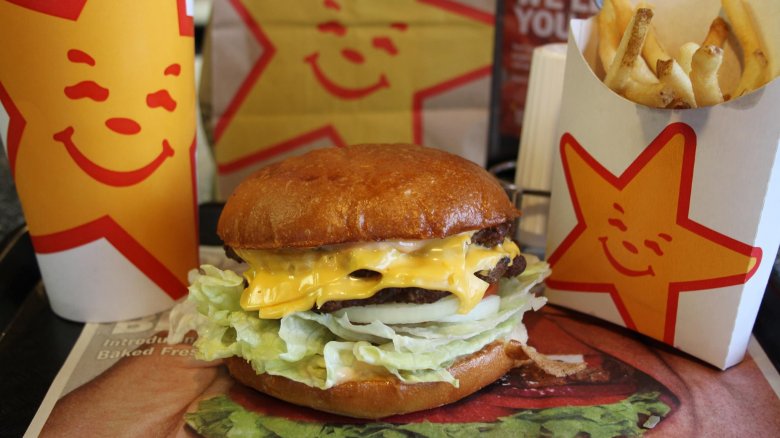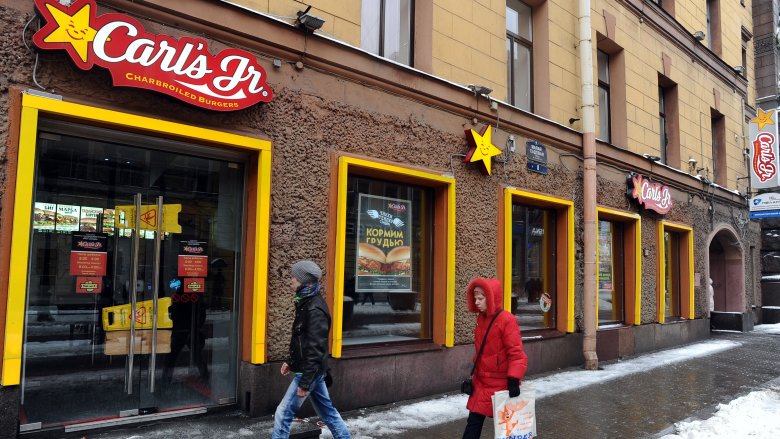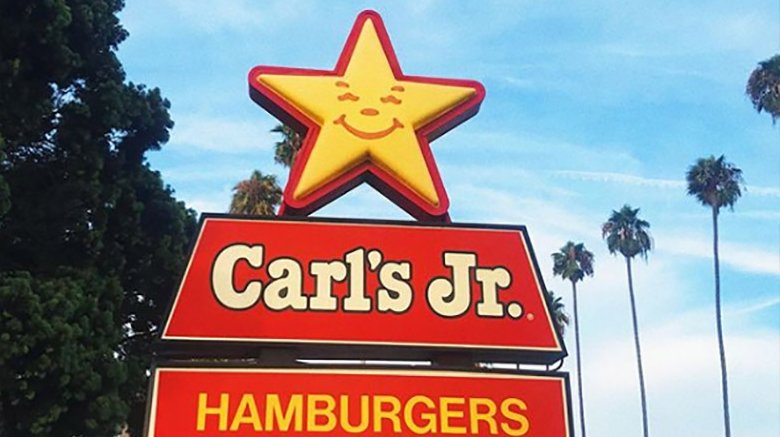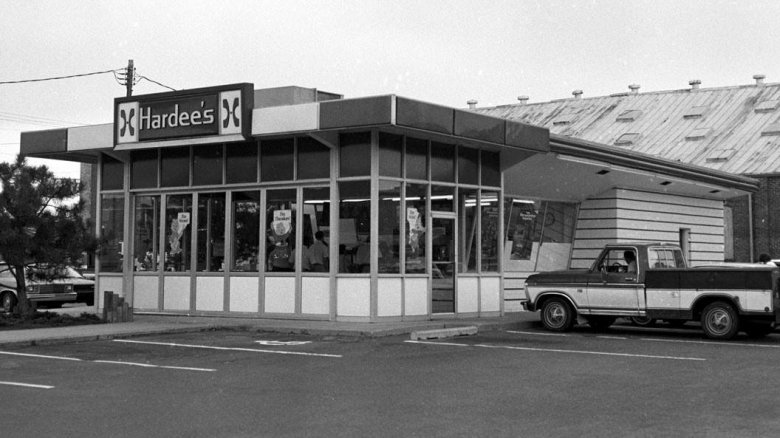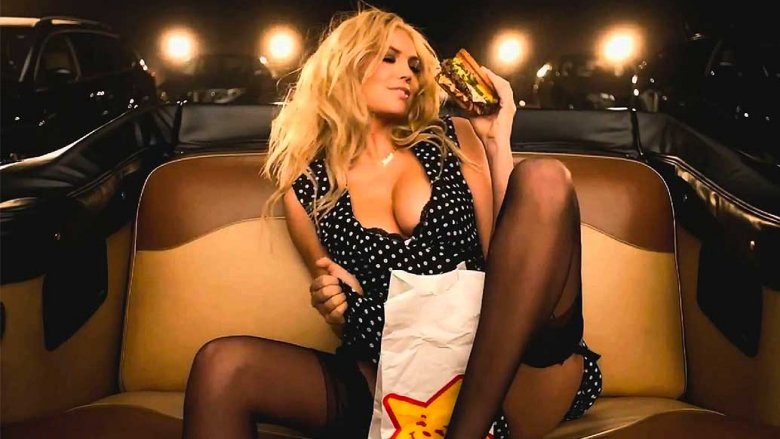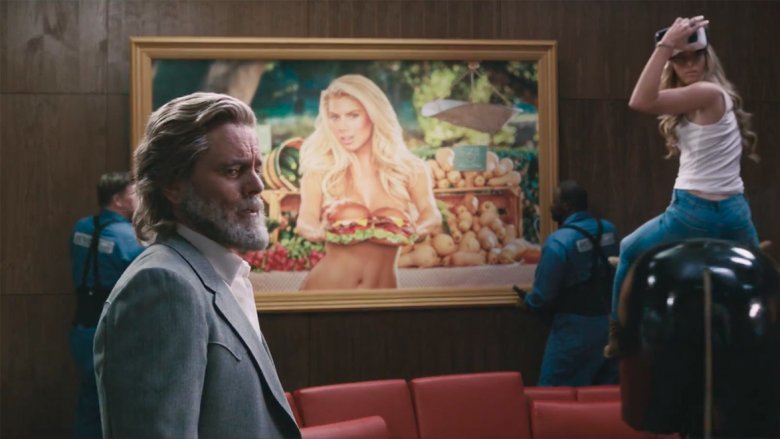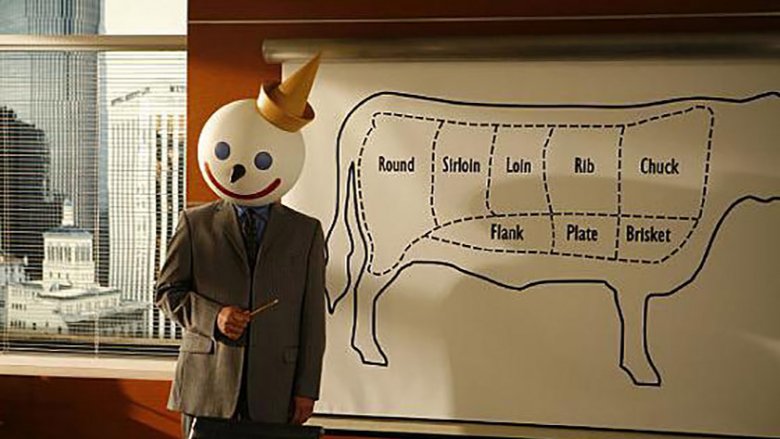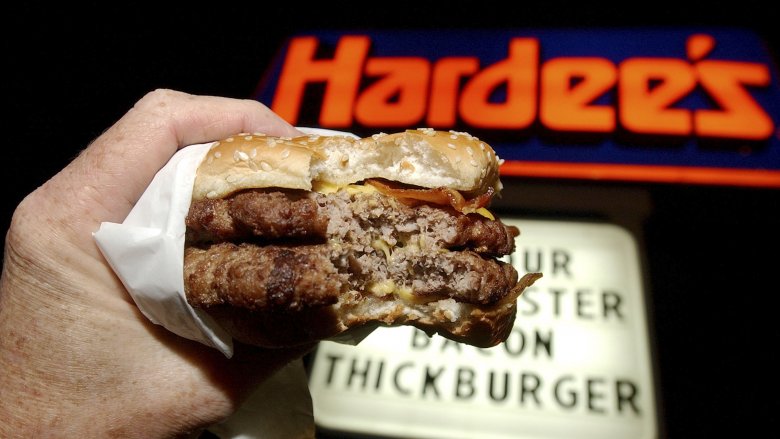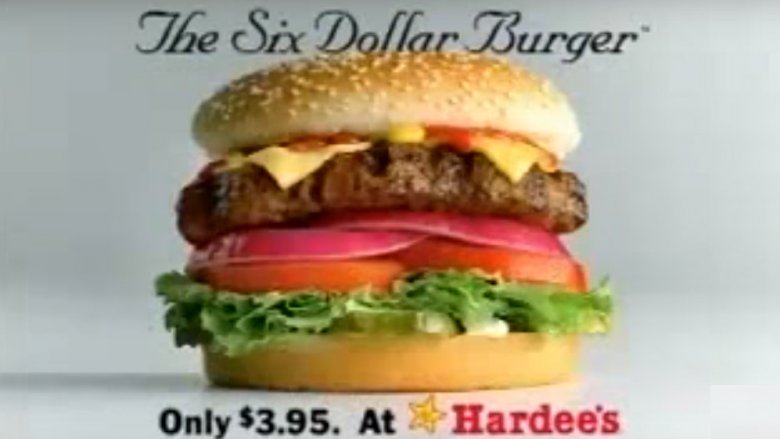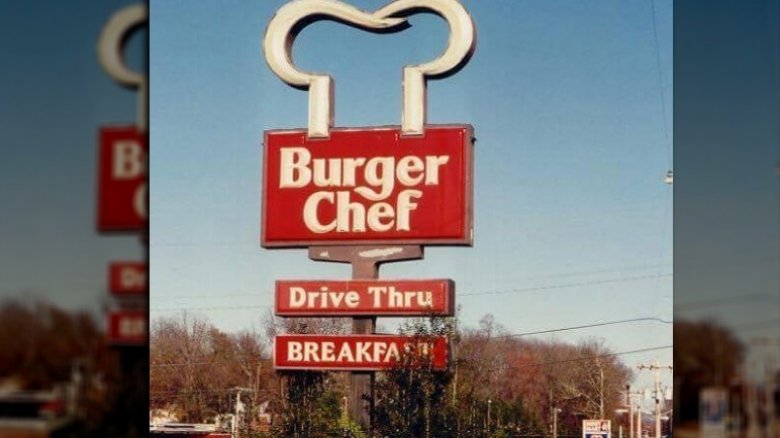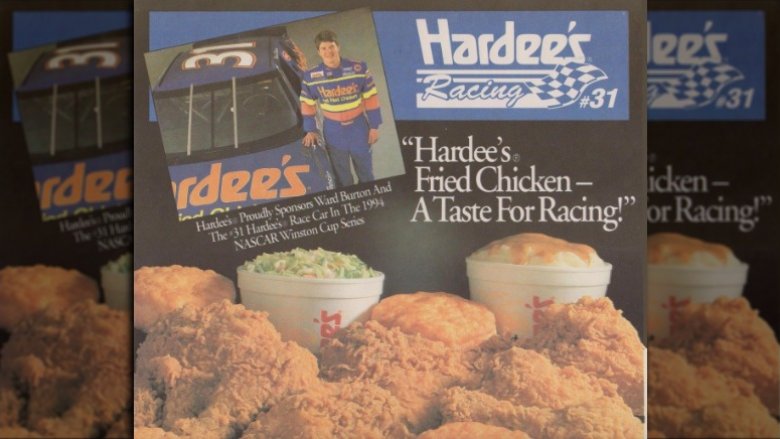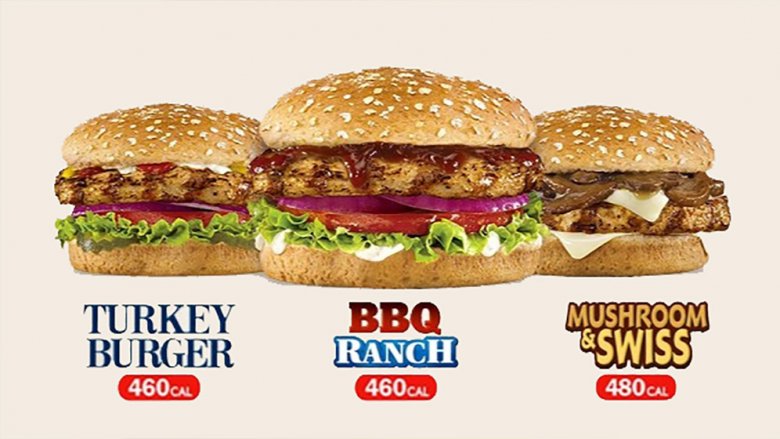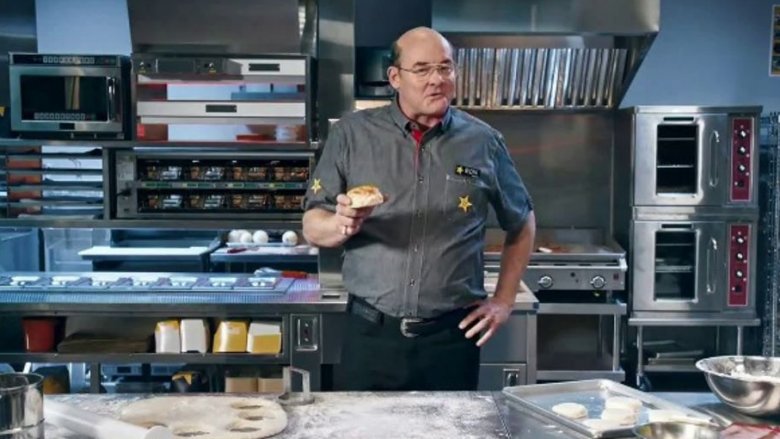The Untold Truth Of Hardee's
Fact: If you go into a Hardee's on a Saturday morning you will see a group of old timers hanging out. It's not just seniors of course who enjoy Hardee's. The restaurant has grown into one of the most popular fast food chains in the United States and is heavily focused on winning over millennial and Gen-Z patrons. But Hardee's climb to fast food success has been anything but a smooth ride.
The burger chain, which was started by Wilbur Hardee in 1960, has had quarrels with other fast food restaurants and been accused of lewd and sexist advertising. Like the biscuits that Hardee's cranks out each day though, Hardee's has risen to the challenge and reshaped its menu and image numerous times over the years. Here's everything you didn't know about Hardee's — the good, the bad... and why some of you may know it better as Carl's Jr.
Its identity depends on which state you're in
It's a question that has plagued its fans since the dawn of time — or at least the 1960s — what's the difference between Hardee's and Carl's Jr.? They both look identical on their websites, so what gives? The short answer: it's all about location.
Hardee's started in North Carolina in the 1960s, but Carl's Jr. first popped up in California 20 years prior. IN the '90s, Carl's Jr.'s parent company bought Hardee's and rather than risk losing an already established identity, simply decided to keep each name the same. For about a decade, each restaurant also kept it's own menu, but eventually, the two merged completely. Whether you you're eating at a Hardee's or Carl's Jr. is merely based on geography.
Even more bizarre, some states such as Oklahoma and Wyoming have both restaurants! Carl's Jr. does offer salads and Hardee's doesn't, so there's that. As far as which taste better, well, that's a topic of internet debate that nobody is going to win.
They're breaking up with Carl's Jr.
Rebranding the Hardee's/Carl's Jr. image wasn't just about ditching the bikinis, but driving home the point that the two brands had separate identities — despite nearly the same menu. Parent company CKE Restaurant's CEO Jason Marker essentially sees the company as having two distinct personalities. Hardee's is the middle America, reserved, and always authentic side, while Carl's Jr. is the "bold, aggressive, impossible to ignore" side.
CKE is following up on this approach by adding more focus on biscuits and chicken tenders in its Hardee's locations to tap into its "Midwestern and Southern roots." Meanwhile, on the Carl's Jr. side, they've recruited Matthew McConaughey put more focus on its burgers. The two campaigns are completely separate and in an interview with Nation's Restaurant News, Marker emphasized the importance of appealing to its customer base in the #MeToo era.
"We don't want to ostracize a gender group, and, of course, the reality is with these strong legacy brands you have to always ensure you remain relevant to up-and-coming user groups," he said.
Just to clarify, you can get burgers, biscuits, and chicken tenders at both restaurants — you just might have a different actor in your commercials.
The founder may have lost the company in a poker game
Wilbur Hardee's 15-cent hamburgers were a hit with Greenville, North Carolina when he opened his first Hardee's in 1960. In the first four months he netted a profit of $9,500 and set his sights on growing the business. Unfortunately for Hardee, his vision of expanding came with a heavy price.
Hardee wanted his next location to be in Rocky Mount, North Carolina and partnered with accountant Leonard Rawls and businessman Jim Gardner. Rawls and Gardner convinced Hardee they could become rich by selling the restaurants as franchises. The company went public in 1963, but Hardee's partnership with Rawls and Gardner turned sour. One version of the story says that Hardee lost his control of the company during a late night poker game during which he had been drinking heavily.
In Hardee's own self-published autobiography, however, he insists that the two men liquored him up over a steak dinner before tricking him into signing away control of the company.
Either way, the next morning Rawls and Gardner had control of 51 percent of the company and all Hardee could do was admit that he had screwed up. "I was stupid," he said during a 1984 interview. "That's what I was. You know how it is — you make mistakes."
The chain has had plenty of advertising controversy
Hardee's may not have coined the term "food porn," but they surely took the phrase and ran with it all the way to the bank. Maybe you remember the ads for Hardee's Thickburgers and their other monster-sized sandwiches from a few years ago. Basically, it's what would happen if Hardee's brought a bunch of hamburgers to a Maxim photo shoot and told the camera guy their commercials simply couldn't have too many cleavage closeups.
The ads were featured during the Super Bowl, had models like Heidi Klum and Kate Upton, but we're called out for being ridiculously sexist by numerous media outlets.
Andy Puzder, then-CEO of Hardee's parent company, CKE, defended the controversy around the advertisements in 2015 and said he wasn't bothered if some people found the commercials offensive. "I like beautiful women eating burgers in bikinis," Pudzer said before adding "I think it's very American." As controversial as the advertising strategy was, it worked. The videos raked in millions of views on YouTube and added a boost to profits, according to Pudzer.
Obviously, Hardee's and Carl's Jr. is in the business of making money, and that can be tricky when objectifying 50 percent of the market. By 2017, the bikini-heavy ads were on their way out and Hardee's had a new game plan.
An attempt at rebranding had a mixed reception
So how does a company that once believed hot models sell burgers turn around its image without losing profits? With a rugged-looking older man in a sharp suit, that's how! In order to get people's minds off bosoms and back on burgers, Hardee's created the fictional character Carl Hardee Sr.
The three-minute commercial featured a Hardee's office run by a spoiled Carl Hardee Jr. who is booted from his seat by Carl Hardee Sr. (Charles Esten) in an effort to remind people Hardee's was a burger pioneer. Another ad featured Carl Hardee Sr. blowing up his son's bikini collection.
"It was time to evolve," said creative director Jason Norcross, who's company 72andSunny created the ad. "Some of the product attributes got lost because people were too busy ogling girls."
As well-intentioned and humorous as the ads were, the fast food chain still had its critics who felt the commercial played into dated female stereotypes.
"If Carl's Jr. were re-branding itself to depict women as multidimensional human beings, that would be commendable," said Glamour. "But it looks like the revised brand image still portrays them as objects — just objects that don't belong in burger ads endorsing traditional American values."
You can't please everybody.
Hardee's had serious beef with Jack in the Box
Leave it to Hardee's to get offended by a commercial and accuse a competitor of demonstrating poor taste in advertising. Oh, the irony.
In the first decade of the new millennium, Hardee's was all about Angus beef, touting its Thickburger merits in every commercial they could. Jack in the Box picked up on this and its marketing team tapped into their inner middle schoolers to create a somewhat clever, but more juvenile commercial.
In the ad, Jack in the Box employee's refer to competitors' Angus burgers and allude to the idea that "Angus" equals "anus." Ha. Ha.
Pudzer said Jack in the Box was "not being funny" and "They need to stop misleading people about what Angus beef is." What a second, it gets even better.
CKE filed a lawsuit and presented the judge with a survey they conducted that revealed out of 404 people, 36 percent thought that Angus beef came from a cow's anus. CKE pushed to get the ads removed from the air for tarnishing the proud reputation of Angus, but it was dismissed with the two companies eventually coming to an agreement outside of court.
Hardee's had an Angus rivalry with McDonald's
While we're on the subject of Angus, we can't talk about Hardee's Angus Thickburgers without discussing the beef war they had with McDonald's. If fast food history has taught us anything, it's that if McDonald's sees somebody else having great success, they're going to try to capitalize on it.
"Don't believe the McHype," was the message to America from Hardee's regarding McDonald's Angus Third Pounder burgers. The 2009 Hardee's press release made clear that they considered the McDonald's burger a copycat, and boasted about how they had released 40 limited-time burgers in the eight-year window McDonald's spent developing one.
At the time of the Angus Third Pounder's release, then-CKE CEO Andy Puzder criticized McDonald's for their Dollar Menu and said their burger wasn't just inferior — it was more expensive. "They're perceived as the value leaders, but their comparable burgers cost more," Pudzer said. "We make a bigger burger, a better burger, and it costs less."
While the two competed for the market of fast food Angus beef lovers in the years that followed, McDonald's eventually bowed out and pulled their burger in 2013. Hardee's then jumped on the opportunity to steal some customers from McDonald's and released a video of Pudzer directing customers right into the burger-offering arms of Hardee's.
"So if you're wondering where the beef is, we have it," Pudzer said. "And we'd never deprive you of it."
Those sound like fighting words for sure. Right, McDonald's?
Their Six Dollar burger was a big move
A $6 burger in today's ever-increasing fast food burger market probably seems like a deal, or at least average in price. Back in 2001, however, paying $6 for a cheeseburger at a fast food joint was a bit of a stretch.
The big catch of course with Hardee's Six Dollar Burger was that the burger wasn't $6, but closer to around four bucks. The name was a play on words with Hardee's telling customers that they could get a burger worthy of a$6 price tag at a full-service restaurant, but at a cheaper price. "It's set us on a course toward the fast-casual segment with a more premium product," Hardee's spokesperson Jana Shortt said.
An increase in profits for three consecutive months and a Silver Skillet Award for "best sandwich" only proved how popular the Six Dollar Burger was with the public.
The burger was discontinued in 2008, only to be brought back for a limited run a year later in order to beat out McDonald's competing Angus burgers. Hardee's still has plenty of big burgers — only these days you probably will have to pay $6 for one.
They killed off a fast food pioneer
Ask any Midwestern baby-boomer about Burger Chef and they'll likely have fond memories of the popular chain's Super Shef and Funburger. The fast food chain was an innovator in the industry, but was eventually gobbled up by the big dogs — with Hardee's delivering the final blow.
In the early 1970s, it was second only to McDonald's in number of locations and franchisees were enjoying a 50 percent return on investments. The fast food joint was even referenced in the TV show Mad Men, just to give you an idea of its popularity at the time.
Their purchase by General Foods started their downhill decline, and mismanagement and bad press only made things worse. In 1981, Hardee's swooped in and bought Burger Chef for $44 million. From there, Hardee's began slowly either closing every Burger Chef location or converting them into Hardee's restaurants. By the end of 1996, the last Burger Chef in Cookeville, Tennessee was gone for good.
They tried to compete with KFC's fried chicken
Maybe you've seen Hardee's commercials boasting about their hand-breaded chicken tenders and thought "Yum, Hardee's serves chicken now!" Well, it's not the first time they've tried serving fried chicken, it's just the most recent.
Back in the 1990s, Hardee's was all about fried chicken and made a valiant effort to compete with Colonel Sanders and his Kentucky Fried Chicken empire. This was likely a result of Hardee's buying the Roy Rogers chain and attempting to incorporate their fried chicken success into its own restaurants. Hardee's claimed their chicken won out over KFC in taste tests, but alas, it wasn't meant to be.
By the early 2000s, Hardee's had decided to devote itself to focusing on burgers, and cut 40 items from their lunch and dinner menus. Unfortunately, their fried chicken was one of the menu items left behind, leaving us to suspect it may not have been as popular as they implied.
Their turkey burgers were a first for fast food
With beef recalls in the news more often and red meat's link to an increase in heart disease, you'd think turkey burgers would be on more fast food menus. Sure some fast food chains have tried out the idea of turkey burgers, but it was Hardee's who rolled them out first.
In 2011, Hardee's teamed up with Men's Health and the editors of Eat This, Not That! to create its turkey burgers that clocked in at 500 calories for the health conscious. CKE Restaurants' VP of marketing, Brad Haley, touted the burgers for being healthy and delicious saying, "More customers today are looking for great-tasting burgers that are better for them and/or are available with a beef alternative."
Except critics didn't seem to think the burgers were particularly "great-tasting." One review from Serious Eats said it had "a strange, almost rubbery texture." Hmm, maybe they meant "rubbery" in a good way?
"It reminded me of the gruel in The Matrix: food that doesn't taste like anything because it has been engineered to be healthy," the continued.
Guess not.
Celebrities have been appearing in their commercials for decades
KFC might have a cast of celebrity Colonels and Arby's has Ving Rhames pitching their meats, but Hardee's has both beat with its celebrity pitches. We touched earlier on models like Heidi Klum and Kate Upton appearing in ads for the brand, but that's just the tip of the iceberg.
Back in the 1970s, Hardee's recruited Cass Elliot from The Mama's & The Papas to sing a jingle for them. Cut to the 1980s, and the fast food chain tapped claymation sensation the California Raisins to advertise their cinnamon raisin biscuits. By the late 1990s, Hardee's and Carl's Jr. had changed their logo to a smiling star with SNL comedian Norm MacDonald's voice.
It was in the 2000s that CKE really seemed to begin pulling more celebrities into its adverts. The brand kick-started its scantily-clad women/burgers commercials with Paris Hilton at a car wash in 2005. From there, everyone from reality stars like Kim Kardashian and Audrina Partridge to Top Chef host Padma Lakshmi and pro-fighter Ronda Rousey found themselves being seduced by hamburgers.
Fast forward to 2018, and they've got Matthew McConaughey repping Carl's Jr. and actor David Koechner pushing Hardee's.
